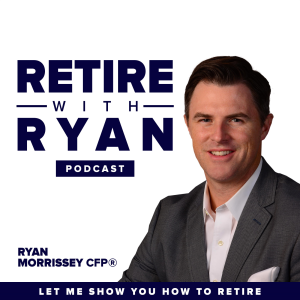
Retire With Ryan
Business & Economics Podcasts
If you're 55 and older and thinking about retirement, then this is the only retirement podcast you need. From tax planning to managing your investment portfolio, we cover the issues you should be thinking about as you develop your financial plan for retirement. Your host, Ryan Morrissey, is a Fee-Only CERTIFIED FINANCIAL PLANNER TM who lives and breathes retirement planning. He'll be bringing you stories and real life examples of how to set yourself up for a successful retirement.
Location:
United States
Description:
If you're 55 and older and thinking about retirement, then this is the only retirement podcast you need. From tax planning to managing your investment portfolio, we cover the issues you should be thinking about as you develop your financial plan for retirement. Your host, Ryan Morrissey, is a Fee-Only CERTIFIED FINANCIAL PLANNER TM who lives and breathes retirement planning. He'll be bringing you stories and real life examples of how to set yourself up for a successful retirement.
Language:
English
Email:
cheryl@morrisseywm.com
Major Changes Coming To 401K, 403B, and 457 Retirement Plans in 2026, #280
Duration:00:16:19
Mapping Out A Plan For Roth Conversions, #279
Duration:00:17:58
Social Security 2026 Cost Of Living Update, #278
Duration:00:13:05
What is a Fiduciary Advisor and Why It Matters, #277
Duration:00:17:50
Switching Plans and Saving Money During Medicare’s Annual Open Enrollment, #276
Duration:00:13:28
Key SECURE Act Insights on Avoiding 25 Percent Penalties on Inherited IRAs, #275
Duration:00:14:39
Seven Essential Tips to Maximize Your Lifetime Social Security Benefits, #274
Duration:00:16:30
What Retirees Need to Know About The Social Security Fairness Act, #273
Duration:00:14:16
Is a Million Dollars Enough to Retire? #272
Duration:00:14:46
Avoid These Seven Medicare Enrollment Mistakes and Protect Your Finances, #271
Duration:00:28:11
Education Planning After the One Big Beautiful Bill Act: Key 529 Plan Changes, #270
Duration:00:11:03
Maximizing Spousal Social Security Benefits for Married Couples, #269
Duration:00:12:16
Understanding HSA Changes for 2026, #268
Duration:00:17:46
Surviving the ACA Subsidy Cliff, #267
Duration:00:22:02
Understanding the New Charitable Contribution Rules from the One Big Beautiful Bill Act, #266
Duration:00:12:50
Should You Open a Trump Account for Your Child’s Future? #265
Duration:00:14:32
How the One Big Beautiful Bill Act Impacts Retirees, #264
Duration:00:15:23
Required Minimum Distributions Explained, #263
Duration:00:23:07
How the Big Beautiful Bill Impacts Solar & EV Tax Credits, #262
Duration:00:14:12
Risk and Reward of Withdrawing Social Security Benefits to Invest Them, #261
Duration:00:15:35